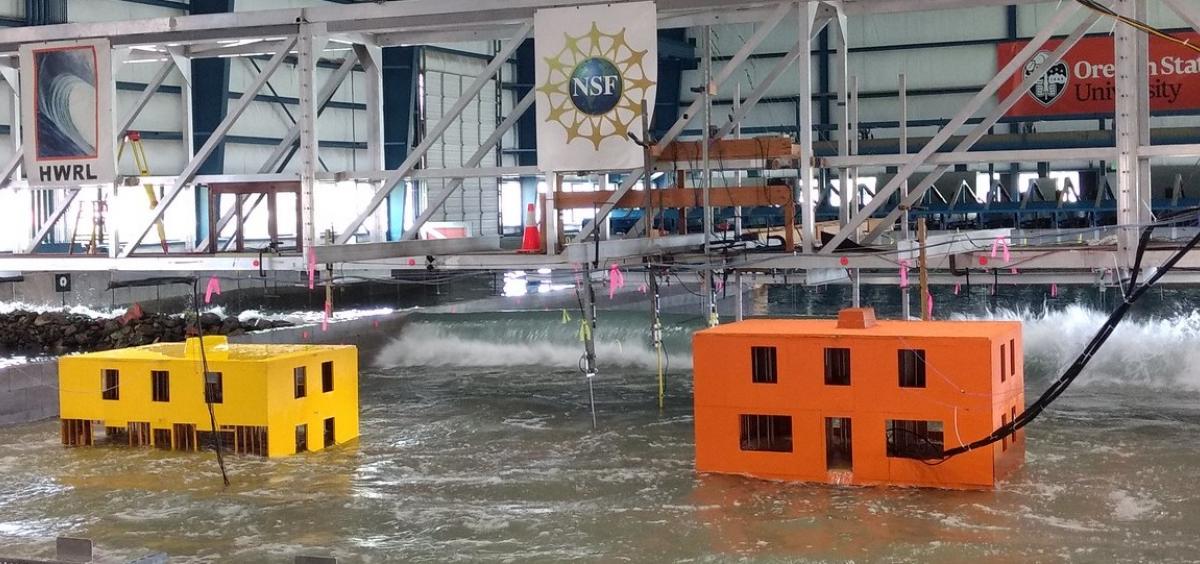
CORVALLIS, Ore. – A pair of scale model structures subjected to simulated storm conditions in an Oregon State University lab responded like real wood-frame homes during recent hurricanes, suggesting model buildings can yield important design information for low-lying areas vulnerable to storm surges and big waves.
“We wanted to establish a way to build scaled wood-frame specimens that would behave, and ultimately fail, under wave loading like their full-scale counterparts have been observed to,” said Sean Duncan, who led the study as a graduate research assistant with the Oregon State College of Engineering. “And we also set out to develop an equation that could predict the distribution of the uplift pressure on elevated structures. We were able to accomplish both of those goals.”
One of the model structures was elevated – built so that the living areas would be off the ground – and the other was “on grade,” or on the ground. As the researchers expected, the on-grade model couldn’t withstand water levels as high as the raised one, and both sustained damage in ways consistent with what was seen in real residential structures during Hurricane Sandy in 2012 and Hurricane Ike in 2008.
The research by Duncan, OSU colleagues Dan Cox, Andre Barbosa and Pedro Lomonaco and collaborators from the University of Hawaii and the University of California, Berkeley, also showed that a remote sensing method known as LiDAR could track the models’ damage progression as the waves and storm surges increased in intensity.
The models were built to one-sixth scale, with strength and stiffness on par with real residences such as those hit by Hurricane Sandy in Ortley Beach, New Jersey, and by Hurricane Ike on Texas’ Bolivar Peninsula. Each of those storms caused extensive damage, which focused greater attention on coastal communities’ vulnerability to waves and storm surges, and on learning more about how to design and construct storm-resistant homes, Duncan said.
“Populations in those types of communities are rising, and so are sea levels,” said Duncan, now a ports and marine engineer with WSP USA in Federal Way, Washington. “That means risk associated with hurricanes is rising too, especially because research indicates hurricanes are increasing in intensity and will continue to do so. That’s why it’s so important to understand the forces these storms generate and how coastal structures respond, so planners and the construction industry can work together to mitigate the potential damage from these very likely, very potent storms.”
Placed on a simulated coastline in the Directional Wave Basin at the O.H. Hinsdale Wave Research Laboratory, the models experienced waves and water depths replicating conditions of Hurricane Sandy. The basin is 48.8 meters long, 26.5 meters wide and just over 2 meters deep, and multiple instruments measured the hydrodynamic loads.
Vertical forces on the elevated specimen were shown to correlate with wave height, air gap and water depth, Duncan said, with the forces peaking in the deepest water at maximum submergence.
“Uplift pressure is also affected by how and where the waves break,” he said. “Waves that broke right on the specimens generally caused bigger vertical forces. And the predictive equation we developed, based on wave height and air gap, is valid for a range of structure length to wavelength ratios, wave heights, air gaps and water depths.”
Air gap refers to the elevation of the bottom of the lowest horizontal member, or LHM, of an elevated structure relative to the still water level.
Findings were published in Coastal Engineering, and the research was supported by Department of Homeland Security and the National Science Foundation.
About the OSU College of Engineering: The college is a global leader in artificial intelligence, robotics, advanced manufacturing, clean water and energy, materials science, computing, resilient infrastructure and health-related engineering. Among the nation’s largest and most productive engineering programs, the college awards more bachelor’s degrees in computer science than any other institution in the United States. The college ranks second nationally among land grant universities, and fifth among the nation’s 94 public R1 universities, for percentage of tenured or tenure-track engineering faculty who are women.
Steve Lundeberg, 541-737-4039
[email protected]
Click photos to see a full-size version. Right click and save image to download.